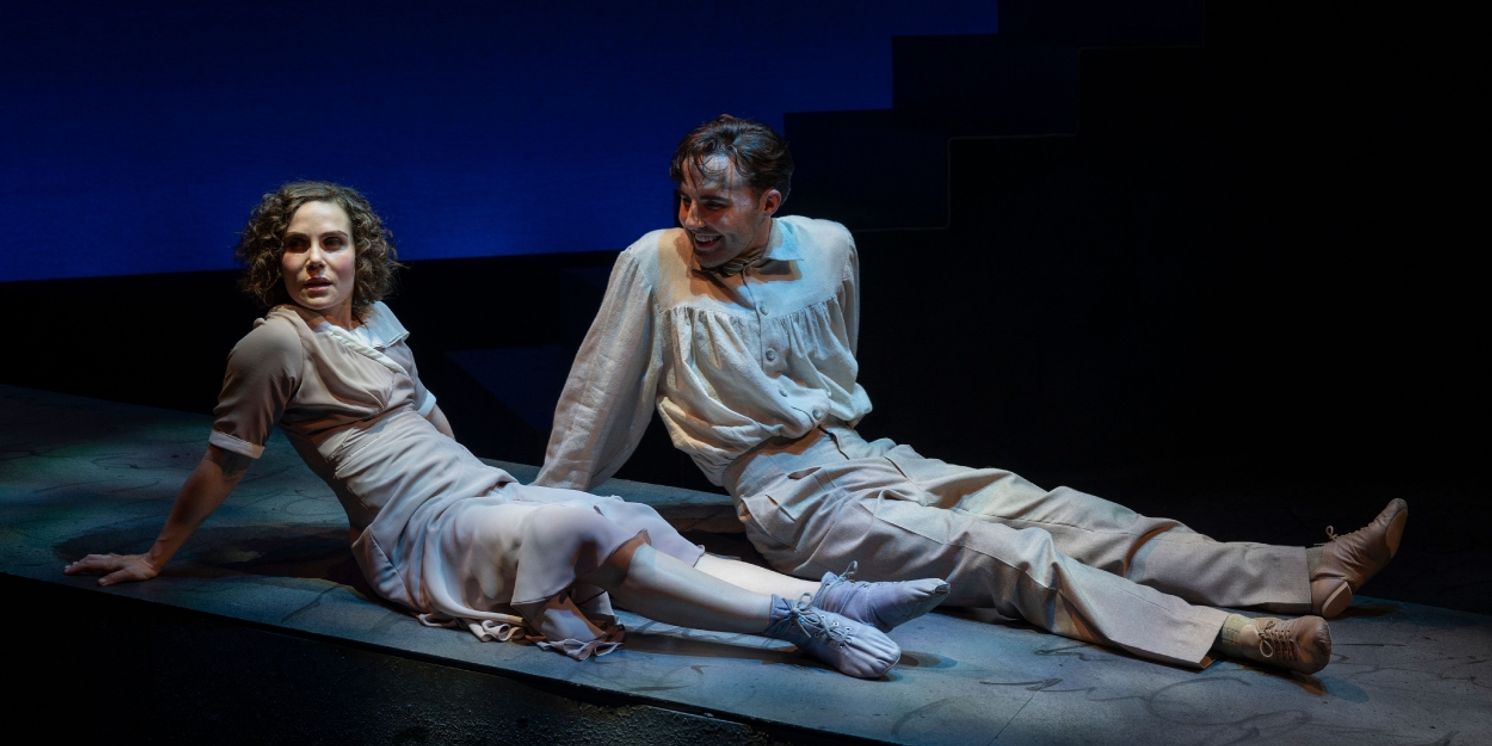Review: THE FLYING LOVERS OF VITEBSK at Northlight Theatre
This mesmerizing play-with-music runs through October 6 in Skokie.

For those who worship at the altar of Fine Art, few experiences can compare to basking in the melancholic blue glow of Marc Chagall’s America Windows installed far into the Art Institute of Chicago’s Modern Art galleries. Each of the windows’ panels emphasizes different artistic forms (music, painting, literature, architecture, theatre, and dance) through a thoughtful blending of color, imagery, and—in early drafts—even language. The windows are often considered the culmination of Chagall’s artistic genius, creating a reverent space in the museum that encourages viewers to contemplate and celebrate human creativity in all its forms. It’s perhaps unsurprising, then, that a dramatic adaptation of Chagall’s life and work should similarly blend disparate art forms to question how artists are not only shaped by the world but how they shape our perception of it in return. Now receiving its Chicagoland premiere, Northlight Theatre’s THE FLYING LOVERS OF VITEBSK features brilliant performances and moments of exquisite stagecraft, though the play’s lean script occasionally saps the production of necessary tension and greater thematic depth. This mesmerizing play-with-music runs through October 6 at the North Shore Center for the Performing Arts in Skokie.
First produced in 2016, Daniel Jamieson’s THE FLYING LOVERS OF VITEBSK dramatizes the 35-year romance between Marc Chagall (Jack Cahill-Lemme) and his wife Bella Rosenfeld (Emma Rosenthal), an underappreciated but talented writer in her own right. Through a blending of dialogue, dance, and folk music composed by Ian Ross, the play traces Marc and Bella’s lives from the small Belarusian town of Vitebsk on the Russian border through some of the most tumultuous periods of the 20th-century, including World War I, the Russian Revolution, the rise of Modernism and the advance of fascism across Europe, and eventually the Nazi occupation of France. But through it all, the couple’s relationship sustains them both artistically and spiritually as they strive to create art and a family together in the face of seemingly endless death and destruction. The cast is rounded out by two backing musicians, Elisa Carlson and Michael Mahler, who also play necessary ensemble roles.
Director Elizabeth Margolius recreates the whimsical energy of Chagall’s works through her inventive staging, having the couple twist and bend and yearn to reach one another just as they do in the artist’s most famous paintings. The actors’ movements inhabit a fascinating space somewhere between choreography and acrobatics, emphasizing the passion and eroticism that charged the Chagalls’ individual creative outputs.
And Margolius’s ecstatic vision is brought brilliantly to life by her two leads. Cahill-Lemme’s bright smile, youthful energy, and crystalline tenor make him a powerfully charismatic Chagall, the kind of idealistic artist that any young person might follow to the ends of the world. This quality proves especially helpful in making Chagall likable as a person even when he’s at his most disappointing as a spouse, such as when he questions Bella’s commitment to her art. For her part, Rosenthal’s Bella is radiant with joy from the moment she steps onto the stage, savoring the emotion in her every turn of phrase with such delight that I found myself wondering if Bella’s own writing conveyed the same love of poetry.
The couple are complemented well by Mahler and Carlson, whose musical and dramatic talents flesh out the play without ever distracting from its central focus. No doubt they’re helped in large part by Mahler’s music direction and Willow James’s sound design, both of which allow vocals and instrumentation to blend seamlessly together to create some appropriately haunting soundscapes.
In fact, Margolius and her creative team aren’t afraid to capture Chagall’s grotesqueries as well as his ecstasies. This is a man whose paintings feature lovers unnaturally contorting their bodies just to earn a simple kiss, a man whose “Praying Jew” kneels before a shapeless black void that threatens to envelop him. Scott Penner’s set design achieves a similar effect, stacking what appears to be concrete slabs on top of one another to create steep staircases from which metal poles jut into the air. The space appears to be coated in a thin layer of dust (or is it ash?) into which someone has traced words and phrases in foreign tongues. The effect is appropriately ominous and helps to convey the palpable sense of danger constantly present in the Chagalls’ lives but often absent from Jamieson’s script. It’s bothersome that a play shaped by calamitous, world-historical events lacks a strong sense of the existential tension that drove Chagall and Bella to seek a better life for their family while testing the bonds of their love. It’s only late in the play--when illness settles into the Chagall household--that there is any true sense of suspense.
But perhaps, like Chagall’s stained-glass windows, THE FLYING LOVERS OF VITEBSK serves more as a space for contemplation than as a provider of easy answers or tidy storytelling. I knew within the first five minutes of the play that I hadn’t seen anything quite like it before, and almost as quickly, I began composing a mental list of all the loved ones I knew who would find joy and excitement in this work as well. As we enter yet another divisive electoral season in this American life, it’s a small comfort to be reminded that art creates meaningful, loving communities that sustain us even in the darkest of times.
Photo Credit: Michael Brosilow
Reader Reviews
Videos

